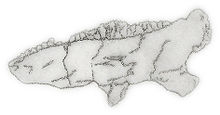
Scelidosaurus is a genus of herbivorous armoured ornithischian dinosaur from the Jurassic of England.

Lufengosaurus is a genus of massospondylid dinosaur which lived during the Early Jurassic period in what is now southwestern China.
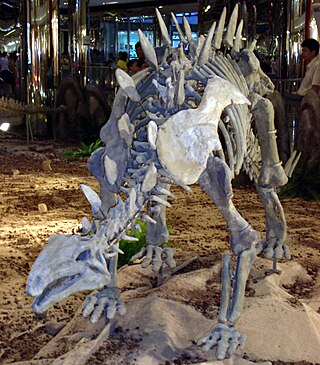
Huayangosaurus is a genus of stegosaurian dinosaur from the Middle Jurassic of China. The name derives from "Huayang" (華陽), an alternate name for Sichuan, and "saurus", meaning "lizard". It lived during the Bathonian to Callovian stages, around 165 million years ago, some 20 million years before its famous relative, Stegosaurus appeared in North America. At only approximately 4 metres (13 ft) long, it was also much smaller than its famous cousin. Found in the Lower Shaximiao Formation, Huayangosaurus shared the local Middle Jurassic landscape with the sauropods Shunosaurus, Datousaurus, Omeisaurus and Protognathosaurus, the ornithopod Xiaosaurus and the carnivorous Gasosaurus.
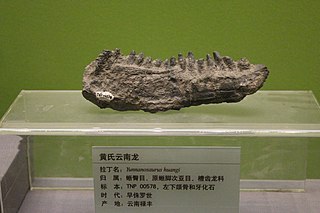
Yunnanosaurus is an extinct genus of sauropodomorph dinosaur that lived approximately 199 to 183 million years ago in what is now the Yunnan Province, in China, for which it was named. Yunnanosaurus was a large sized, moderately-built, ground-dwelling, quadrupedal herbivore, that could also walk bipedally, and ranged in size from 7 meters (23 feet) long and 2 m (6.5 ft) high to 4 m (13 ft) high in the largest species.
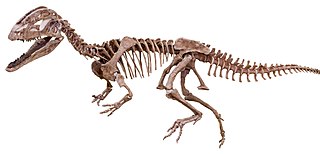
Sinosaurus is an extinct genus of theropod dinosaur which lived during the Early Jurassic Period. It was a bipedal carnivore similar to Dilophosaurus, with proportionally large limbs to its slender body. Fossils of the animal were found at the Lufeng Formation, in the Yunnan Province of China.

Bienosaurus is a dubious genus of thyreophoran dinosaur from the Lower Jurassic Lower Lufeng Formation in Yunnan Province in China.

Gyposaurus is a genus of basal sauropodomorph dinosaur from the early Jurassic of South Africa. It is usually considered to represent juveniles of other prosauropods, but "G." sinensis is regarded as a possibly valid species.

Emausaurus is a genus of thyreophoran or armored dinosaur from the Early Jurassic. Its fossils have been found in Mecklenburg-Vorpommern, northern Germany. Emausaurus is the only known Toarcian thyreophoran, as well as the only dinosaur from the zone of the same age with a formal name.
Eshanosaurus is a genus of a dinosaur from the early Jurassic Period. It is known only from a fossil partial lower jawbone, found in China. It may be a therizinosaurian, and if so the earliest known coelurosaur.
Gongbusaurus is a genus of ornithischian, perhaps ornithopod, dinosaur that lived between about 160 and 157 million years ago, in the Late Jurassic period. A small herbivore, it is very poorly known. Two species have been assigned to it, but as the original name is based on teeth, there is no concrete evidence to connect the two species. Its fossils have been found in China.

Lukousaurus is an archosauromorph based on most of a small skull's snout, displaying distinctive lachrymal horns, found in the Early Jurassic-age Lower Lufeng Formation, Yunnan, China and was described by Chung Chien Young in 1940. The generic name refers to the Lugou Bridge, lit. “crossroads”, near Beijing, where the Sino-Japanese War started. L. yini is tentatively classified as a theropod dinosaur by some allied to ceratosaurs, by others a coelurosaur. Its skull is rather robust for its size though the teeth were described by the author as typically theropodan. Whatever Lukousaurus was, it was definitely an archosauromorph.
The Lufeng Formation is a Lower Jurassic sedimentary rock formation found in Yunnan, China. It has two units: the lower Dull Purplish Beds/Shawan Member are of Hettangian age, and Dark Red Beds/Zhangjia'ao Member are of Sinemurian age. It is known for its fossils of early dinosaurs. The Dull Purplish Beds have yielded the possible therizinosaur Eshanosaurus, the possible theropod Lukousaurus, and the "prosauropods" "Gyposaurus" sinensis, Lufengosaurus, Jingshanosaurus, and Yunnanosaurus. Dinosaurs discovered in the Dark Red Beds include the theropod Sinosaurus triassicus, the "prosauropods" "Gyposaurus", Lufengosaurus, and Yunnanosaurus, indeterminate remains of sauropods, and the early armored dinosaurs Bienosaurus and Tatisaurus.
The Chuanjie Formation, is a geological formation in Yunnan, China. It dates back to the Middle Jurassic. It was formerly referred to as being the lower member of the "Upper Lufeng" as opposed to the underlying "Lower Lufeng" now referred to as the Lufeng Formation. Tracks of theropods and sauropods, as well as thyreophorans are known from the formation.
Phyllodontosuchus is a genus of sphenosuchian, a type of basal crocodylomorph, the clade that comprises the crocodilians and their closest kin. It is known from a skull and jaws from Lower Jurassic rocks of Yunnan, China. Phyllodontosuchus is unusual because some of its teeth were leaf-shaped, like those of some herbivorous dinosaurs, and it does not appear to have been a strict carnivore like most other crocodylomorphs.

Dibothrosuchus is a genus of sphenosuchian, a type of basal crocodylomorph, the clade that comprises the crocodilians and their closest kin. It is known from several partial skeletons and skulls. These fossils were found in Lower Jurassic rocks of Yunnan, China. Dibothrosuchus was a small terrestrial crocodylomorph that probably had a keen sense of hearing, and thus was probably a vocal animal like modern crocodilians.

Platyognathus is an extinct genus of protosuchian crocodyliform. Fossils are known from the Early Jurassic Lower Lufeng Formation in Yunnan, China and belong to the type and only species, P. hsui.
Shuangbaisaurus is genus of theropod dinosaur, possibly a junior synonym of Sinosaurus. It lived in the Early Jurassic of Yunnan Province, China, and is represented by a single species, S. anlongbaoensis, known from a partial skull. Like the theropods Dilophosaurus and Sinosaurus,Shuangbaisaurus bore a pair of thin, midline crests on its skull. Unusually, these crests extended backwards over the level of the eyes, which, along with the unusual orientation of the jugal bone, led the describers to name it as a new genus. However, Shuangbaisaurus also possesses a groove between its premaxilla and maxilla, a characteristic which has been used to characterize Sinosaurus as a genus. Among the two morphotypes present within the genus Sinosaurus, Shuangbaisaurus more closely resembles the morphotype that is variably treated as a distinct species, S. sinensis, in its relatively tall skull.

Bashanosaurus is an extinct genus of stegosaurian dinosaur from the Middle Jurassic Shaximiao Formation of Yunyang County, China. The genus contains a single species, Bashanosaurus primitivus, known from incomplete skeletons belonging to three individuals. It is one of the basalmost stegosaurs, as well as one of the oldest known stegosaurs, along with Adratiklit, Isaberrysaura, and Thyreosaurus.
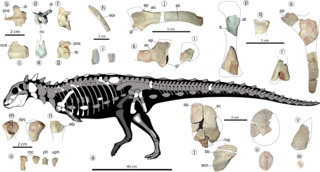
Jakapil is a genus of basal thyreophoran dinosaur from the Candeleros Formation of Argentina. The type species is Jakapil kaniukura.

Baiyinosaurus is an extinct genus of stegosaurian dinosaurs from the Middle Jurassic Wangjiashan Formation of China. The genus contains a single species, B. baojiensis, known from a partial skeleton including cranial bones. The skeletal anatomy of Baiyinosaurus demonstrates transitional features between basal thyreophorans and stegosaurs. While many stegosaurs are known from China, Baiyinosaurus is the only one currently named from Gansu Province.
